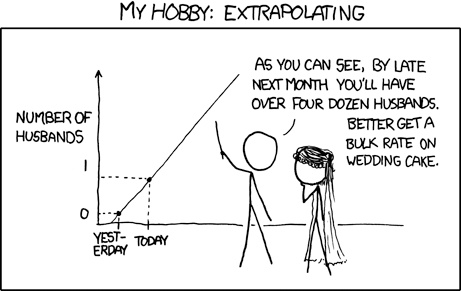Time Series Models
Time series models are a little different from other models that we’ve seen in R. With most other models, the goal is to predict a value (the response variable) from a set of other variables (the predictor variables). Usually, we explicitly assume that there is no autocorrelation: that the sequence of observations does not matter.
With time series, we assume the opposite: we assume that previous observations help predict future observations (see Figure 23-1).

Figure 23-1. Extrapolating times series
To fit an autoregressive model to a time series, use the
function ar:
ar(x, aic = TRUE, order.max = NULL,
method=c("yule-walker", "burg", "ols", "mle", "yw"),
na.action, series, ...)Here is a description of the arguments
to ar.
| Argument | Description | |
|---|---|---|
| x | A time series. | |
| aic | A logical value that specifies whether the Akaike information criterion is used to choose the order of the model. | TRUE |
| order.max | A numeric value specifying the maximum order of the model to fit. | NULL |
| method | A character value that specifies the method to use for
fitting the model. Specify method="yw" (or method="yule-walker") for the
Yule-Walker method, method="burg" for the Burg method,
method="ols" for ordinary
least squares, or method="mle" for maximum likelihood
estimation. | c(“yule-walker”, “burg”, “ols”, “mle”, “yw”) |
| na.action | A function that specifies how to handle missing values. | |
| series | A character vector of names ... |
Get R in a Nutshell now with the O’Reilly learning platform.
O’Reilly members experience books, live events, courses curated by job role, and more from O’Reilly and nearly 200 top publishers.

